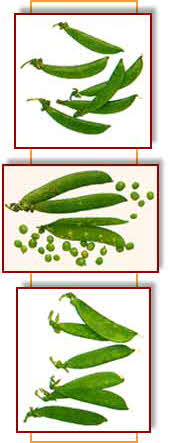Home | FOOD ARTICLES | Food Trivia | Today_in_Food_History | Food_History_Timeline | Recipes | Cooking_Tips | Food_Videos | Food_Quotes | Who’s_Who | Culinary_Schools_&_Tours | Food_Trivia_Quizzes | Food_Poems | Free_Magazines | Food_Festivals_and_Events
Food Articles, News & Features Section
FREE Magazines
and other Publications
Free Professional and Technical Research, White Papers, Case Studies, Magazines, and eBooks
PEAS
See also: Pea Trivia; Pea Quotes; Recipes for Peas
Peas have been used in the dry form since ancient times, and archaeologists found them in Egyptian tombs. It was not until the sixteenth century that more tender varieties of this vegetable were developed and eaten fresh. Today only about 5 % of all peas grown are sold fresh. More than half of all peas sold are canned and most of the rest are frozen.
Green peas are actually a member of the legume family. This family includes plants that bear pods enclosing fleshy seeds. Green peas do not require the long cooking times that are required by dried legumes such as split peas and pinto beans. Peas are a good low calorie source of protein. A 100-calorie serving of peas (about ¾ cup) contains more protein than a whole egg or a tablespoon of peanut butter and has less than one gram of fat and no cholesterol.

Selection
Fresh green peas should be refrigerated. Half of their sugar content will turn to starch within six hours if they are kept at room temperature. Low temperatures also preserve their texture and nutrient content. Look for pods that are firm, have glossy pods with a slightly velvety feel, filled to appear almost bursting, and peas should not rattle loosely in the pod. Pods should not be dull, yellowed, or heavily speckled.
Snow peas should be shiny and flat, with very small peas that are barely visible through the pod. Smaller pods are the sweetest and the most tender. Sugar snap peas should be bright green, plump, and firm.
Storage
It is best to serve all types of fresh peas the day they are purchased. If they must be stored, place them in a perforated plastic bag in the refrigerator. Do not wash them before they are stored. Shell green peas right before you cook them.
Preparation
Rinse peas before shelling them. To shell peas, pinch the stem off with your fingernails and pull the string down the length of the pod. The pod will pop open and the peas can be pushed out of the pod with your thumb. When finished, wash all peas.
Rinse snow peas and sugar snap peas before use. To trim snow peas, cut the tips from both ends of the pod. This can be done with kitchen shears. Sugar snap peas need to have the strings removed before eaten cooked or raw. The string runs around both sides of the sugar snap pod. It is easiest to start from the bottom tip and pull the string up the front, and then snap the stem off and pull the string down the back of the pod.
Varieties
Green peas are nestled within large, bulging, grass green pods that are typically round and sweet. The green pea pods are tough, do not have good flavor, and therefore, are not eaten.
Snow peas (Chinese pea pods) and sugar snap peas are more often found fresh, but many companies are now selling them frozen. These peas are eaten raw or cooked with the pod intact. Snow peas supply less protein and are lower in B vitamins than green shelled peas because they are eaten when their seeds are still immature. However, snow peas provide almost twice the calcium, 100 % of the RDA for vitamin C, and slightly more iron than green peas.
Make Peas a Part of Your 5 A Day Plan
* Season cooked peas with fresh or dried mint, chopped fresh parsley, curry powder, or with lemon.
* Add shelled green peas, snow and sugar snap peas to tossed green or pasta salads or to stir-fried dishes.
* Snow and sugar snap peas can be eaten raw as a snack or with your favorite low-fat dip.
RELATED ARTICLES
Please feel free to link to any pages of FoodReference.com from your website.
For permission to use any of this content please E-mail: james@foodreference.com
All contents are copyright © 1990 - 2025 James T. Ehler and www.FoodReference.com unless otherwise noted. All rights reserved.
You may copy and use portions of this website for non-commercial, personal use only.
Any other use of these materials without prior written authorization is not very nice and violates the copyright.
Please take the time to request permission.


